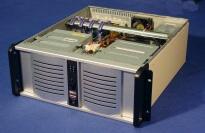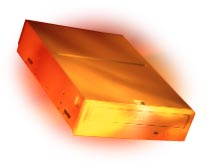 |
The RME Reference
PC - Hardware recommendations
The RME Reference PC Intel Professional consists of an exceptional 19" case, a fast Intel Pentium 4 processor, a motherboard with Rambus memory interface, 512 MB RAM, IBM hard-drives with a constant data transfer rate higher than 20 MByte, fast but silent 16/48-times DVD/CD-ROM drive, up-to-date 24-times CD-RW burner and a dual monitor graphics card. After a long time of legitimate warnings against a current-hungry Pentium 4 and expensive RAMBUS memory, both technologies have developed and are now the key factors for outstanding performance - the foundation-stone of every professional DAW. The Case Usual 19" cases are hardly appropriate for audio
- inflexible, too big and much too expensive. Mostly only two hard-drives
and one CD-ROM can be fitted - that's it. The new RME Reference Case however
provides ideal DAW conditions at a depth of only 48 cm / 1.6 ft:
This case will again be equipped with the proven Enermax power supply, the latest 350 Watts server model with ball-bearing dual fans and manual fan pre-setting. Thus the convincing power reserves are provided at minimal noise disturbance. The Motherboard
Unfortunately, due to bad the sales, RAMBUS boards have been neglected by all motherboard manufacturer's for a long time - if they even had one to offer at all! We would happily move to one with more features like integrated network card, additional RAID controller and especially 6 PCI slots - but this doesn't seem to exist at the moment. And can be understood even less, if you realize that the extended interrupt controller (APIC) found in the i850 (i845D too) will allow to use 24 interrupts (instead of 15) - and XP indeed makes use of those. So there will be no interrupt sharing any longer when using a lot of devices. For full performance, we recommend PC800 RDRAM, which shows an incredible transfer rate of 1.5 GByte/s with Sandra's memory benchmark. The CPU With the Pentium 4 CPU, Intel have trapped themselves up in the beginning. Much too high a price, much too high a power consumption and not at all convincing performance (the first CPUs ran only at 1.3 GHz) made many computer manufacturer's simply ignore the P4. On top, there was hardly any P4-optimized software, and the required RAMBUS memory was just not affordable.
The best value for money at the moment is the 2.0A GHz model. The performance difference compared to PIII processors is between 60% and 200%, depending on the measurement procedure. In practice, this is not only clearly noticeable, but allows especially for CPU-demanding applications like PlugIns, for a much higher number of those. The Hard Disks Modern hard drives have become so unbelievable fast, even cheaper models are sufficient for the majority of multitrack recordings. Nevertheless we still recommend and include two of this top model: The IC35L040 Deskstar 60GXP from IBM with ATA100 interface, average data transfer rate 23,2 MByte per second (c't 12/2001). This hard disk raises only an eye-brow when performing 96kHz/24bit multitrack recordings. Further specs: 40 GByte, 7200 RPM, 2 MByte cache, average current consumption and thus no critical temperature reaction. Very quiet. SCSI? Never... The DVD/CD-ROM Drive
The CD Writer
The Teac CD-W524E comes with 2 MB internal memory and Burn-Proof*. Besides 24x write CD-R, 10x write CD-RW and 40x read CD-ROM it also grabs audio with bit-accuracy and up to 30x. In contrast to some similar drives of other brands, it contains a UDMA2 interface and thus provides full compatibility with hard-drives working on the same IDE channel. Besides, it operates in whispers. The writer comes bundled with the latest Nero 5.5, a powerful, professional writer software, which excited us already after the first minutes of usage. *Even when the internal cache runs empty (Buffer Underrun) and Windows freezes for minutes the writer will continue with highest precision at the exact sector where it stopped. Thus this device can guarantee to finish the CD-ROM writing and to produce a valid CD, no matter what you do with your PC while in the writing process. A must have for professionals. The Graphics Card
You don't need a second monitor? Everyone who has worked in 'stereo' for at least 1 hour knows it better. A second monitor is no luxury, but actually worth every single penny. Considering the cost for a complete system (computer, RME DIGI card and software cost around 2500 EUR, another 350 EUR for a 19" monitor is not that much more. Even when it is required later or when you intend to use an additional monitor that you already own, the Matrox Dual Head will be the basis for flexibility and sensibility.
Please note: Although we have set up and tested everything ourselves, we can still make mistakes. We would like to clarify that all information included in this Tech Info is both our subjective opinion and subject to permanent change. This Tech Info is not to be understood as a do-it-yourself instruction, any request on this behalf can not be responded to and will be deleted immediately. RME is not selling computers and will not be. In case you want to avoid buying and assembling of all the parts our German based customers can get in touch with: Retail source All RME Reference PCs are available completely assembled and pre-installed. Tillmann Computer Systeme in Hannover are assembling the systems strictly according to our instructions and test them prior to shipment. Even the drivers for all RME cards and DIGICheck are preinstalled. Note that RME digital cards are only available through authorized dealers, thus not included in these computer systems. Prices - Professional, parts as described above, incl. optical
mouse, keyboard and Windows XP Pro: 2559 Euro incl. VAT
Copyright © Matthias Carstens, 2001/2002. |
||
Copyright © 2002 RME. All rights reserved.
RME is a registered trademark. |



 This
has changed. The latest CPUs with 512 kB cache (Northwood) are made in 0.13µ
technology, reach considerably higher clock rates, provide incredible performance
and even need less current at the same time. The chip-sets are fully developed,
RAMBUS memory is still more expensive than normal SDRAM, but not unaffordable
anymore. And many software packages are P4-optimized.
This
has changed. The latest CPUs with 512 kB cache (Northwood) are made in 0.13µ
technology, reach considerably higher clock rates, provide incredible performance
and even need less current at the same time. The chip-sets are fully developed,
RAMBUS memory is still more expensive than normal SDRAM, but not unaffordable
anymore. And many software packages are P4-optimized.


